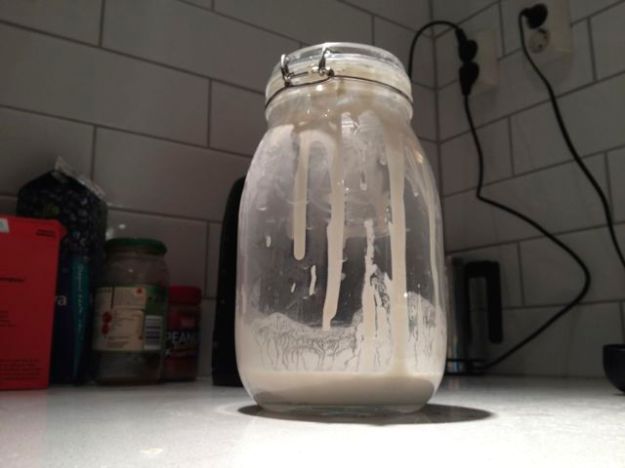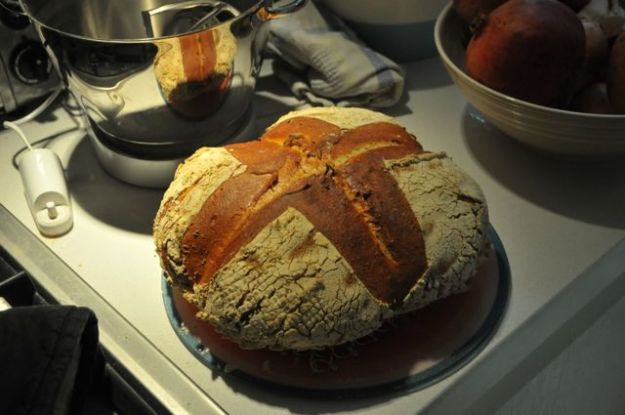Here’s the thing: I’m lazy, and wanted an easy way to achieve perfect results.
Annalisa sent me sourdough starter two months ago. She also sent me instructions about what to do with it. I fed it and watered it and it grew.
On the day I made my first bread I followed Annalisa’s instructions to the letter: knead after ten minutes, ten minutes, ten minutes, 30 minutes, 60 minutes, 60 minutes and finally 120 minutes.
The flour on the board was a rookie mistake: I should have used oil. Annalisa put me right on that, sternly but kindly.
Still, the bread worked. Yes, I undercooked it, and yes, the shape was all wrong, but although it wasn’t beautiful it tasted delicious.
Seven kneads, though? Seven? Far too much work, I decided.
I tried a friend’s easy sourdough recipe, which calls for no kneading. You take your starter, mix in 700ml water and 500g flour, along with a little salt, and let it stand in a bowl in the fridge over night.
Then you add another 500g flour, mix it all up, and spoon the runny dough into two bread tins. You return the tins to the fridge for a few hours. No kneading. Simple.
The result wasn’t bad. The bread rose well in the tin and the taste was actually pretty good, but the bubbles were small, and the sides of the tin had prevented the crust from darkening properly.
Worse, though: it just wasn’t sour enough, which was the point as far as I was concerned. I’d have been happy if I’d bought it from a shop, but not if I’d bought it as sourdough bread.
I wanted an artisan bread, but with less work kneading than Annalisa insisted on. I had a kitchen machine. So, could I industrialise the process?
The short answer is: sort of. It took a lot of trial-and-error, but it did work.
You put the starter into the bowl in the mixer. You put on the whisk attachment and start the machine running slowly. Then you add the water, and then spoon in the flour very slowly until the whole thing forms a smooth dough. If you’re me, you forget the salt. You switch off the machine and wait ten minutes.
Now you change the attachment to the K-beater. You do your three first kneads on maximum power for ten seconds each time. By now you have something that looks like a proper bread dough. After each knead, you scrape excess dough off the K-beater with a knife.
Then, and only then, do you change to the dough hook. After thirty minutes you run the machine on maximum power for ten seconds, and you do the same for the next three kneads, after an hour, and hour, and two hours. Each time you have to scrape the dough off the hook.
Then you put the dough into your banneton, and from that point on the process is identical to the hand-knead process. It makes a good sourdough, which improves the longer you extend the final prove.
There’s only one problem. My industrial method is far harder work than the hand-kneading. It’s messy; it covers everything in a hard sheet of sourdough which is very difficult to clean, and you have to use three attachments. It’s a complete waste of time.
In fact, once you’ve got used to making sourdough by hand it’s easy. You get a sense of how the dough should feel in your hand, and when you need to add a little more water, or a little more flour. You knead for ten seconds a time. That’s it. Suddenly it slots into your life, becomes a pleasure not a chore.
But laziness has taught me some useful lessons. The best is this: if you mistreat your starter, which I often do, by not feeding it every day, it produces a more acidic taste, which I really like.
And salt – I know they say you need it to get a decent prove, and a decent crust, but you really don’t. After completely forgetting to add salt a couple of times, I can’t detect any difference in texture between unsalted and “properly” salted sourdough. I now add a fraction of what you’re supposed to use, and the bread is excellent.
I cheat on ice – I just throw a small glass of water into the oven to produce the necessary steam – and I don’t own a proper banetton so I improvise with a cloth, a wire fruit bowl and lots of flour.
But I slash. Always.
Ben McPherson is a TV producer and writer.









